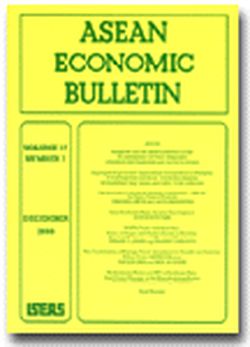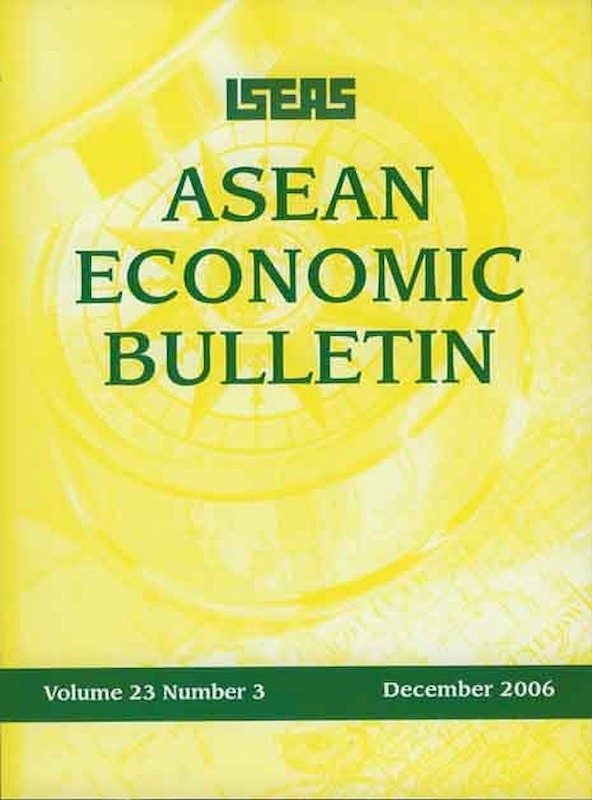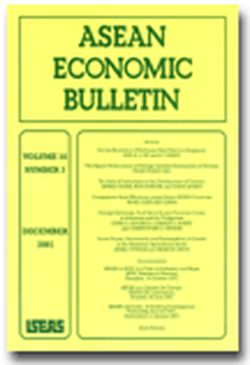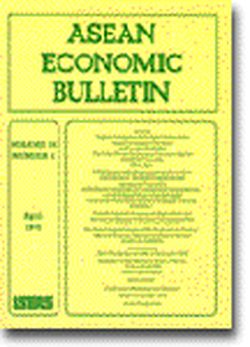ASEAN Economic Bulletin Vol. 17/3 (Dec 2000)

Date of publication:
December 2000
Number of pages:
121
Code:
AE17/3
Contents
-
Preliminary pages
- ARTICLES
-
Singapore and the Asian Economic Crisis: An Assessment of Policy Responses, by David Schulze, Mahinda Siriwardana, authors see abstractSingapore seems to have weathered the financial storm of East Asia better than most in the region. Yet it was not spared from contagion. Economic growth slowed from 7.8 per cent in 1997 to 1.5 per cent in 1998. The declining regional demand for Singapore's exports due to contraction in the crisis economies and loss of competitiveness in the face of competitive devaluations posed new challenges for Singapore which had to adopt policies to combat the crisis. This article examines the effects of proposed policies using a computable general equilibrium model. We find that the wage reduction and devaluation policies are more promising than domestic demand stimulation.
-
Aggregate Imports and Expenditure Components in Malaysia: A Co-integration and Error Correction Analysis, by Tang Tuck Cheong, Mohammad Haji Alias, authors see abstractThis article examines the long-run relationship between Malaysian aggregate imports and the components of final demand expenditure and relative prices using Johansen multivariate co-integration analysis. An error correction model is proposed to model the short-run response of imports to its determinants. Annual data for the period 1970 to 1998 are used. The long-run relationship between aggregate imports and the macroeconomic components of final demand expenditure namely public and private consumption expenditure, investment expenditure and exports, is investigated because the different components of final demand might have different import contents. If this were true, the use of a single demand variable in the aggregate import demand function would lead to aggregation bias. The results of the analysis show that the components of final demand expenditure and relative prices are all important in determining aggregate demand for imports in both the long-run and the short-run.
-
The Sources of Industrial Growth in Indonesia, 1985-95: An Input-Output Analysis, by Agus Hermawan, Takahiro Akita, contributors see abstractThis article analyses structural changes and the sources of industrial growth in Indonesia between 1985 and 1995 by using the 1985, '90, and '95 input-output tables. It also investigates the changes in the pattern of industrial growth over the 25-year period of 1971-95. In the past three decades, Indonesia appears to have achieved a successful transition from an inward-looking, government-led industrialization financed by oil exports to an outward-looking, market-oriented industrialization based on non-oil exports, in which the turning period was during the 1980-85 period. During 1985-95, the expansion of household consumption remained the main source of output growth as it accounted for about one-half of total output growth; in contrast, the contribution of government consumption was reduced to a negligible level, signifying the declining role of the government sector in output growth. The expansion of exports was also a key factor in output growth in addition to the rise in export-oriented investments. It is noteworthy that export expansion was made, to a large extent, by non-oil exports, rather than oil exports.
-
Intra-Southeast Asian Income Convergence, by Donghyun Park, author see abstractThe next challenge for ASEAN, which has been a successful and effective forum for political co-operation among Southeast Asian countries, is to promote greater economic co-operation. Income convergence helps to promote economic integration in the long run. This article examines the issue of convergence among Southeast Asian economies during 1960-97. No evidence of convergence is found.
-
NAFTA Trade with East Asia: Rules of Origin and Market Access in Textiles, Apparel, Footwear and Electrical Machinery, by Masaru Umemoto, William E James, authors see abstractRules of origin govern preferential trade in the North American Free Trade Agreement (NAFTA). A model of trade in intermediate goods is used to examine the effect of rules of origin on trade between member and non-member countries. High MFN tariffs and quota restrictions on textiles and apparel face East Asian producers, including those in ASEAN, in NAFTA markets but are relaxed for producers within the FTA, including Mexico. Trade diversion on a large scale is thus predicted in textiles and apparel. Evidence of such trade diversion is provided. Within NAFTA, Mexico gains market share in textiles and apparel at the expense of ASEAN and Northeast Asia. However, in Japan ASEAN gains market share.
-
The Contribution of Foreign Direct Investment to Growth and Stability: A Post-Crisis ASEAN-5 Review, by Paul M Dickie, Xiaoqin Fan, authors see abstractThe Asian financial crisis has raised doubts about the role of foreign capital in future economic development of ASEAN. This article looks at the FDI component of foreign capital and examines its contribution to growth and stability in the ASEAN-5 economies. Based upon a simple growth accounting framework, the findings indicated that FDI directly accounted for 4 to over 20 per cent of GDP growth in the ASEAN-5 during the 1987-97 period. Moreover, FDI inflows were found to be a stabilizing factor during the Asian financial crisis. These positive results need to be factored into future policy deliberations on the appropriate role of foreign capital in ASEAN development.
-
Multinational Firms and FDI in Southeast Asia: Post-Crisis Changes in the Manufacturing Sector, by Nick J Freeman, Frank L Bartels, authors see abstractThe real impact of the Asian Crisis on the activities of multinational enterprises with investments in Southeast Asia is only now becoming apparent. This article provides some of the first empirical evidence on this issue, stemming from a survey conducted in mid-1999, amongst retail-oriented multinational firms with regional headquarters located in Singapore. The survey confirms the negative impact of the Asian economic crisis on multinational enterprises' regional operations, and indicates the persistence of structural impediments to foreign investment across parts of the region. The gap between the attractions of the ASEAN-5 countries and the Indochina countries, as hosts for foreign investment, is also becoming more pronounced.
-
BOOK REVIEW: The Indonesian Economy. (2nd edition). By Hal Hill, by Anthony L Smith, author
-
BOOK REVIEW. Technology, Competitiveness and the State: Malaysia's Industrial Technology Policies. Edited by Jomo K.S. and Greg Felker, by Vijayakumari Kanapathy, author
-
BOOK REVIEW. The Economics of Transition in Laos: From Socialism to ASEAN Integration. By Yves Bourdet, by Nick J Freeman, author
-
BOOK REVIEW. Prospects in Trade, Investment and Business in Vietnam and East Asia. Edited by Tran Van Hoa, by Robert L Curry, Jr., author
-
BOOK REVIEW. Taiwan's Development Experience: Lessons on Roles of Government and Market. Edited by Erik Thorbecke and Henry Wan, by Yunhua Liu, author
-
BOOK REVIEW. Competition and the World Economy: Comparing Industrial Development Policies in the Developing and Transitional Economies. By Francisco Sercovich et al., by Peter Wilson, author





